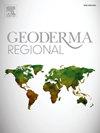Chernozems of Eastern European forest-steppe lowland landscapes: Morphology, classification and spatial distribution
IF 3.3
2区 农林科学
Q2 SOIL SCIENCE
引用次数: 0
Abstract
The chernozems of the flat interfluves in the Oka-Don Lowland exhibit unique characteristics within the chernozem zone. These soils show distinct signs of groundwater-induced waterlogging in the lower part of soil profile and, unlike the chernozems of elevated plains, do not typically experience summer desiccation. This study is based on an analysis of morphological properties and extensive soil surveys encompassing over 2500 soil profiles across an area exceeding 500,000 ha of the Oka-Don Lowland. The research integrates topographic and lithological factors of soil formation alongside the results of large-scale soil mapping conducted on a 400-ha key site.
Using machine learning and digital soil mapping techniques, we identified the key environmental drivers governing the spatial distribution of waterlogged chernozems within the Oka-Don Lowland. The key site revealed distinct spatial patterns of chernozem distribution and their associations in catenas with Solonetz, Gleysols, and Stagnosols. Despite the minimal elevation differences across the flat interfluves, topography emerged as the primary factor influencing soil spatial differentiation.
A comparison of forest-steppe soil classifications between the USSR system and WRB reveals significant discrepancies in their Chernozem categories. For instance, according to the WRB, Chernozems cover 80–90 % of the southern Oka-Don Lowland, whereas the USSR SC classification assigns only 65 % of this area to chernozems. This difference arises because the WRB includes additional soil types in its Chernozem category that the USSR SC classifies differently. Notably, not all soils identified as chernozems in the USSR SC qualify as Chernozems under the WRB; some of them belong to the Phaeozems. Correlating soil taxa at the species level between the USSR SC and WRB results in a loss of critical information regarding soil depth and organic carbon content. This discrepancy can lead to differences of up to 3.5 times in estimates of organic carbon stocks within the 50 cm soil layer.
These inconsistencies underscore the urgent need to harmonize soil classification data and systematically address these differences when assessing soil organic carbon stocks. Such efforts are essential for ensuring accurate carbon accounting and enhancing our understanding of the role of these soils in the global carbon cycle.
东欧森林草原低地景观黑钙土:形态、分类和空间分布
奥卡东低地平坦断流的黑钙土在黑钙土带中表现出独特的特征。这些土壤在土壤剖面的下部显示出地下水引起的涝渍的明显迹象,并且与高架平原的黑钙土不同,它们通常不会经历夏季干燥。这项研究是基于对形态特性的分析和广泛的土壤调查,包括在超过50万公顷的Oka-Don低地的2500多个土壤剖面。该研究将土壤形成的地形和岩性因素与在400公顷关键地点进行的大规模土壤测绘结果结合起来。利用机器学习和数字土壤制图技术,我们确定了控制奥卡东低地涝黑钙土空间分布的关键环境驱动因素。关键样地揭示了黑钙土分布的空间格局及其与Solonetz、Gleysols和Stagnosols的关联。尽管平原间的海拔差异很小,但地形是影响土壤空间分异的主要因素。对比苏联系统和WRB系统的森林草原土壤分类,发现两者的黑钙土分类差异显著。例如,根据世界自然保护区,黑钙土覆盖了奥卡顿低地南部的80 - 90%,而苏联的SC分类仅将该地区的65%分配给黑钙土。这种差异的产生是因为WRB在其黑钙土类别中包含了苏联SC不同分类的额外土壤类型。值得注意的是,并非所有在苏联SC中被认定为黑钙土的土壤都符合WRB规定的黑钙土;其中一些属于费厄赞。在物种水平上对比苏联森林和WRB之间的土壤分类群会导致土壤深度和有机碳含量等关键信息的丢失。这种差异可能导致50厘米土层内有机碳储量估计值的差异高达3.5倍。这些不一致强调了在评估土壤有机碳储量时,迫切需要协调土壤分类数据并系统地解决这些差异。这些努力对于确保准确的碳核算和加强我们对这些土壤在全球碳循环中的作用的理解至关重要。
本文章由计算机程序翻译,如有差异,请以英文原文为准。
求助全文
约1分钟内获得全文
求助全文
来源期刊

Geoderma Regional
Agricultural and Biological Sciences-Soil Science
CiteScore
6.10
自引率
7.30%
发文量
122
审稿时长
76 days
期刊介绍:
Global issues require studies and solutions on national and regional levels. Geoderma Regional focuses on studies that increase understanding and advance our scientific knowledge of soils in all regions of the world. The journal embraces every aspect of soil science and welcomes reviews of regional progress.
 求助内容:
求助内容: 应助结果提醒方式:
应助结果提醒方式:


